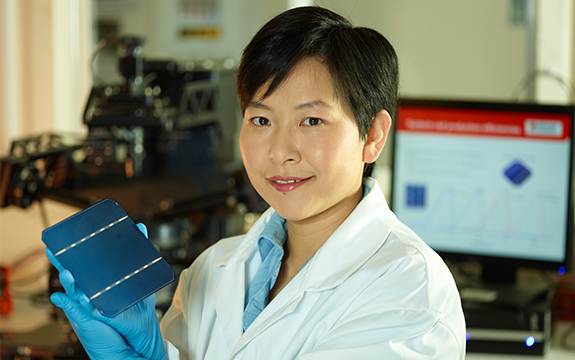Graphene aids lens technology breakthrough

In Summary
- This article will feature in Swinburne’s new ‘Research Impact’ magazine, currently being produced in association with Nature Publishing Group. Look out for ‘Research Impact’ in March 2016
A flat optical lens just a billionth of a metre thick will let us see living creatures as small as a single bacterium better than ever before. The new lens, developed by researchers at Swinburne University of Technology, promises to revolutionise much of the technology around us.
Driven by developments in photonic chips and nano-optics, the global race to create a practical ultrathin lens that breaks the diffraction limit — enabling a focus less than half the wavelength of light — had been gathering pace since the turn of the millennium.
The principle had recently been demonstrated using metal-based materials — predominantly gold — but these were too inefficient and too costly to mass-produce. The development of a practical prototype was hampered by the lack of a suitable material.
Just over two years ago, PhD student at Swinburne’s Centre for Micro-Photonics, Xiaorui Zheng, tried fashioning a lens using graphene oxide — a variation of the super-strong, atom-thick carbon material, graphene. The team, led by Associate Professor Baohua Jia, developed a three-dimensional printer that could quickly and cheaply produce the lens using a sprayable graphene oxide solution. Lasers were used to precisely pattern the surface, creating three concentric rings of reduced graphene oxide, which enabled its extraordinary focus.
The result is a very strong and flexible flat optical lens that is 300 times thinner than a sheet of paper and weighs a microgram — next to nothing. At the same time, it has a precise and adjustable three-dimensional focus that allows a detailed view of objects as small as 200 nanometres long at wavelengths ranging from visible to near infrared.
It’s early days, but the new technology has the potential to reduce the size and weight of mobile phones in which cameras are currently dependent on thick and heavy lenses. If that happens, it will mean that new phone cameras could focus light near the infrared spectrum, allowing thermo-imaging and possible remote medical diagnosis.
The research was only published in September 2015, but Jia and the group are already working towards integrating the lens with fibre to create a much smaller, safer and more sophisticated endoscope for noninvasive surgery.
However, it is likely that the greatest impact of this technology over the long term will be its ability to increase the efficiency of the photonic chip for use in supercomputers and superfast broadband distribution, significantly reducing energy consumption.
“We feel very excited about it,” says Jia. “My team wants to let the world know that we have this fantastic technology and that it will be useful and change their lives.”
Satellite images
Optics researchers with Australia’s Defence Science and Technology Group have begun working with Jia and her Swinburne colleagues to develop their graphene oxide lens technology for use in nanosatellites.
Nanosatellites are tiny box-like satellites weighing between 1 and 10 kilograms that are taking off around the world.
The vast majority of the expense of satellites is bound up in the cost of the launch, which is dependent on its weight.
The optical lenses that are currently used weigh a couple of hundred grams whereas the new lenses developed by the Swinburne group weigh just a microgram. Integrating the lighter lenses with nanosatellites will mean significant cost savings as well as better pictures of Earth and space.
More to explore
Zheng, X., Jia, B., Lin, H., Qiu, L., Li, D. & Gu, M. Highly efficient and ultra-broadband graphene oxide ultrathin lenses with three-dimensional subwavelength focusing. Nature Communications 6, 8433 (2015).

